
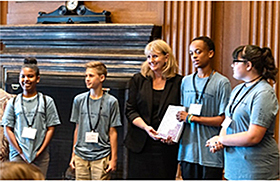 Administrator Harp commends Do The Write Thing Challenge national student ambassadors. Pictured with her are, from left to right, Talayia R., Justin H., Brian J., and Heaven J.
Administrator Harp commends Do The Write Thing Challenge national student ambassadors. Pictured with her are, from left to right, Talayia R., Justin H., Brian J., and Heaven J.
Photo courtesy of the National Campaign to Stop Violence.
The annual Do The Write Thing Challenge is the hallmark program of the National Campaign to Stop Violence. Do The Write Thing encourages middle school students to engage in discussions about youth violence with their teachers and peers, write about their experiences with violence—as well as its causes and solutions, and pledge to do their part to end it.
This year, 78,000 students took the challenge and submitted essays. Since its inception, the National Campaign to Stop Violence estimates that 1 million young people have submitted essays and more than 2 million have participated in classroom discussions through the challenge.
The 2018 winning essayists—known as national student ambassadors—represent challenge programs in 24 cities. Two student ambassadors per city were invited to Washington, DC, to share their stories and learn about the nation’s capital.
“My dad used to hit my mom, which took a huge toll on my life,” wrote Jada C. in her essay shared during the challenge ceremony, which took place at the U.S. Supreme Court on July 16, 2018. “He would also say things that were very hurtful to me. This messed up my self-esteem a lot. This has impacted me at school and growing up. I have a defense mechanism now, which is blocking a lot of people out of my life.”
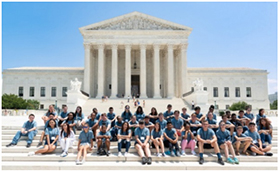 Do The Write Thing Challenge national student ambassadors pictured on the steps of the U.S. Supreme Court.
Do The Write Thing Challenge national student ambassadors pictured on the steps of the U.S. Supreme Court.
Photo courtesy of the National Campaign to Stop Violence.
Ceremony attendees received a book containing Jada’s essay along with those of her fellow student ambassadors. The students also expressed ideas about the causes of and potential solutions to violence within their communities.
Eighth grader George H. wrote about curbing social media’s contribution to cyberbullying. “The best way to stop violence is to spread positivity and love,” he wrote. “I can start speaking up for my friends. A true friend would not allow someone to make others they care about feel doubt or pain. I can start with kind words … . You never know what is going on in someone else’s world, so why not lift them up with kindness?”
“When we fear something or someone, we are restrained from our full potential,” wrote eighth grader Keyli L. “Therefore, always remember that when you overcome fear, nothing can hold you back. In the future, my goal is to be a lawyer and focus on giving a louder voice to children in fear.”
—Kathleen T., eighth grade student and 2018 national student ambassador for the Do The Write Thing Challenge.
Sixth grader Juan T. wrote about growing up fatherless because of violence. “My biological father went to jail, leaving me, my sister, and my brother without a father figure. I was 3 years old when this happened … I do not know how it feels to have a father-son moment.” Although Juan doesn’t think he can change the world, he believes he can impact those around him. “I can create a safe space amongst my friends where we can trust each other, protect one another, and help each other resolve any issues we might encounter. I can also tell a teacher if anything is happening in school or in my community.”
Administrator Harp congratulated the students on their fearlessness and encouraged them to continue to take a stand against violence. “We all know that the answer to violence in our communities does not lie with the federal government alone. It lies with each person within each community. Every one of us has a part to play in keeping our homes, our schools, and our streets safe,” Ms. Harp said.
Resources:
To read more about the National Campaign to Stop Violence and the Do the Write Thing Challenge, visit the National Campaign's website.
Information about OJJDP’s child protection efforts through children’s advocacy centers, the Internet Crimes Against Children Task Force program, and the National Center for Missing & Exploited Children is available online.
OJJDP’s website also provides information on the Office’s violence reduction and prevention initiatives, which include mentoring, gang suppression, and understanding trauma’s impact on children exposed to violence.
The OJJDP-supported Coalition for Juvenile Justice annual conference took place on June 27–30 in Washington, DC. The conference theme was “At the Intersections: How Federal, State, and Local Partners Can Work Together to Improve Juvenile Justice.”
On June 29, 2018, Administrator Harp addressed conference attendees. She shared that OJJDP is undergoing a reorganization to improve its support for the states. The compliance monitoring and program work will now reside in the reconstituted State Relations and Assistance division. OJJDP is also simplifying the process for states to apply for Title II Formula Grants program funds. The streamlined process will also allow OJJDP staff additional time to complete risk assessments and enhanced desk audits of states’ monitoring systems annually, provide technical assistance, and problem solve. Additionally, in 2019, OJJDP will implement a new, outcome-based approach to assess states’ efforts to address the disproportionate contact of minority youth with the juvenile justice system.
Administrator Harp also told attendees that the Office will highlight local successes and showcase successful strategies by posting state action plans, data, and outcomes on the OJJDP website annually. Administrator Harp concluded by emphasizing OJJDP’s commitment to building relationships with the states. “We’re your partners. Good partners hold each other accountable,” she said. “We hold you accountable to the core protections and you hold us accountable to the programming and technical assistance that we are authorized and required to provide to help you meet these goals.”
The Coalition for Juvenile Justice is a nationwide coalition of state advisory groups and allies dedicated to preventing children and youth from becoming involved in the courts and upholding the highest standards of care when youth are charged with wrongdoing and enter the justice system.
Resource:
Additional information about the core requirements of the Juvenile Justice and Delinquency Prevention Act of 2002, and OJJDP efforts surrounding disproportionate minority contact is available on OJJDP’s website.
“Child exploitation, any form of it, is a moral abomination, and within this category of evil is a particular kind of depravity that … comes packaged in online images of children being subjected to the most vile and violent treatment,” said Acting Associate Attorney General Jesse Panuccio in his address at the National Law Enforcement Training on Child Exploitation on June 12, 2018, in Atlanta, GA.
“These images—that, unfortunately, each of you has to investigate on a regular basis—contain some of the most unspeakable violations one individual can perpetrate on another. This is some of the most difficult work in law enforcement, and you are the ones doing it. Thank you.”
The Office of Justice Programs and OJJDP have coordinated this specialized training for several years to expand the efforts and knowledge base of law enforcement investigators, prosecutors, and digital forensic examiners involved in investigating and/or prosecuting technology-facilitated crimes against children. Protecting children from online predation and abuse remains a priority for the current Administration.
Approximately 1,500 people attended this year’s training, including OJJDP Administrator Caren Harp and Deputy Administrator Chyrl Jones. Over the past 20 years, OJJDP has built up the Internet Crimes Against Children Task Force network from 10 original task forces into a nationwide network of 61 task forces representing more than 4,500 federal, state, local, and tribal law enforcement and prosecutorial agencies that work to combat technology-facilitated child exploitation. Since the program’s inception, task force investigations have reviewed more than 775,000 complaints of alleged child sexual victimization, resulting in the arrest of more than 83,000 people suspected of sexually exploiting children—including more than 10,300 in 2017.
Mr. Panuccio noted that opioid abuse has not only become one of America’s most pressing public health and safety crises, but that it will also eventually profoundly impact law enforcement’s work investigating child exploitation. “The line between drug abuse and child maltreatment is short, direct, and well documented," he said. “Some predators will actually generate a dependency on drugs as a means of controlling young people and trapping them in commercial sex work.”
“Our Office of Juvenile Justice and Delinquency Prevention and our Office for Victims of Crime are making $47 million available this year to serve child victims and provide intervention for youth who are at risk of coming into contact with the justice system due to their exposure to opioids,” Mr. Panuccio said.
Then Principal Deputy Assistant Attorney General Alan Hanson also delivered remarks at the event. “Public safety is job number one at the Office of Justice Programs, and protecting children is one of our most critical public safety responsibilities,” Mr. Hanson said. “The safety of our kids depends on highly skilled, highly trained professionals like all of you, and we are committed to providing you the resources your jobs require. We are grateful for all you do, and we are proud to be your ally and your friend.”
Resources:
To access information on preventing child exploitation, visit the OJJDP and NCMEC websites.
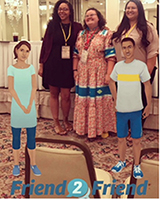 Presenters (left to right) Sutton King, Kaitlin Pinkerton, and Hilary Hullinger appear with Friend2Friend simulation avatars at the 2018 National Unity Conference in San Diego, CA. The simulation teaches high schoolers how to approach friends about sensitive topics. Photo courtesy of OJJDP Tribal Youth Training and Technical Assistance Center.
Presenters (left to right) Sutton King, Kaitlin Pinkerton, and Hilary Hullinger appear with Friend2Friend simulation avatars at the 2018 National Unity Conference in San Diego, CA. The simulation teaches high schoolers how to approach friends about sensitive topics. Photo courtesy of OJJDP Tribal Youth Training and Technical Assistance Center.
The United National Indian Tribal Youth (UNITY) organization is a national network of 160 affiliated youth councils operating in 36 states and Canada and representing thousands of Native youth. UNITY’s mission is to foster comprehensive development of American Indian and Alaska Native youth, and involve them in building and unifying a self-reliant Native America. The organization held its annual conference on July 5–9, 2018, in San Diego, CA. The event drew approximately 2,200 youth and sponsors from across the country.
OJJDP has been a longstanding supporter of the conference, and partnered with UNITY on youth leadership projects as part of OJJDP’s efforts to help tribal communities prevent victimization and juvenile delinquency, reduce violent crime, and improve tribal juvenile justice systems.
On July 8, 2018, Hilary Hullinger, technical assistance coordinator at OJJDP's Tribal Youth Training and Technical Assistance Center, copresented a session on suicide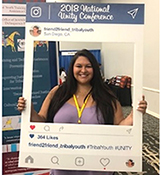 prevention attended by approximately 50 youth.
prevention attended by approximately 50 youth.
During the session titled “Friend2Friend Virtual Suicide Prevention and Training Simulations for Tribal Youth,” Ms. Hullinger—alongside Kaitlin Pinkerton, a youth suicide prevention advocate and member of the Cherokee Nation, and Sutton King, a Kognito, LLC, tribal program specialist and member of the Menominee and Oneida Nations—demonstrated how the OJJDP-supported virtual simulation module, Friend2Friend, helps high school students recognize signs of psychological distress in peers and how to motivate these youth to seek help. Session attendees were encouraged to download the free app to their mobile devices and follow the simulation.
Presenter Hilary Hullinger in San Diego, CA, with OJJDP’s Tribal Youth Training and Technical Assistance Center 2018 National Unity Conference Instagram cutout. Photo courtesy of OJJDP Tribal Youth Training and Technical Assistance Center.
The youth shared stories of instances when the app could have helped them or someone else they knew and expressed an eagerness to share the simulations and help address these issues in their communities.
OJJDP also provided a resource booth at the conference that offered information about and access to Friend2Friend and two other virtual simulation modules—“Trauma-Informed Policing With Tribal Youth” and “At-Risk for High School Educators.” All three modules are available at no cost through OJJDP’s Tribal Youth Training and Technical Assistance Center.
Resources:
More information on OJJDP’s tribal youth programs and services is available online.
OJJDP’s Tribal Youth Training and Technical Assistance Center virtual training simulations and implementation information are free and available for download online.
Bullying is a significant factor in instances of school violence. OJJDP supports school safety and antibullying efforts through its programming and training and technical assistance. As part of the Office's “Lunch and Learn” series, on June 20, 2018, OJJDP’s Training and Technical Assistance Unit hosted Sarah Solano, project assistant at the Police Foundation for an all staff discussion of lessons learned from the foundation’s Averted School Violence Initiative.
Averted school violence is defined as a violent attack planned with or without use of a firearm that was prevented either before or after the perpetrator arrived on school grounds. The Police Foundation created the initiative to bring together law enforcement, school officials, and mental health and other professionals involved in identifying and preventing school attacks, and encourage them to share their stories to prevent future violence across the nation.
Through this initiative, 51 reported incidents have been verified and published in the Averted School Violence database to date. A trusting relationship between school administration and students is one common factor in the submissions. Students feel more comfortable reporting the suspicious behavior of fellow students when they trust that they will be heard. Collected incidents also reinforce the “see something, say something” concept by demonstrating the need for a variety of reporting mechanisms, such as text messaging or phone calls, in addition to face-to-face interactions with a school’s administration.
Collecting indepth information identifies common factors of averted school attacks that can be used to train school personnel, law enforcement, and others to improve school safety. Personnel involved in school attacks are encouraged to submit their information and can do so anonymously. The information is vetted and verified before being added to the database.
Some key takeaways from the initiative are the importance of educating students about warning signs and identifying student safety concerns. It is also important for schools to develop well-trained threat assessment teams that can evaluate a school’s particular safety issues or concerns.
Funded by the Office of Community Oriented Policing Services and the National Institute of Justice, the initiative collects information from open source media reports and court documents, school officials, law enforcement, and others who were successful in averting school violence. The database spans the period since Colorado’s Columbine High School shooting in April 1999 to the present.
OJJDP’s National Training and Technical Assistance Center is collaborating with the Police Foundation on a two-part webinar series to provide practitioners with insight into the prevention of, response to, and recovery from school violence incidents. Part one, “Averting School Violence: Learning Lessons From the School Attack That Didn’t Happen—The Police Foundation’s Averted School Violence Database,” will take place on August 29, 2018, from 2–3 p.m. ET. Presenters will discuss the training provided in schools to help identify behavior that can lead to violence. Part two, “Strategies for the Prevention, Response, and Recovery From Acts of Violence in Schools,” will take place on September 5 from 2–3 p.m. ET, and will explore lessons learned from the response and recovery from acts of school violence.
Resource:
Additional information on OJJDP’s school bullying prevention resources is available online.

Dr. Sanzanna Dean, OJJDP Senior Policy Advisor.
OJJDP Senior Policy Advisor Dr. Sanzanna Dean is dedicated to improving the lives of youth and families. She has 20 years of experience in the expansion, management, and evaluation of youth programs in both the nonprofit and government sectors. Dr. Dean has led and been a member of several multidisciplinary teams on workforce development, child welfare, and juvenile justice, including three Governor-appointed boards in Arizona and Texas.
As a Senior Policy Advisor for OJJDP, Dr. Dean guides and helps develop initiatives that support the implementation of effective strategies to address core issues impacting the juvenile justice system.
She is most passionate about creating opportunities for youth to envision a path to success and pursue their dreams. Shortly after joining OJJDP, Dr. Dean participated in a Department of Justice working group on addressing barriers to reentry. The working group coordinated federal programs and initiatives for people transitioning back to their communities following placement in a juvenile justice facility. As co-chair of the working group’s subcommittee on juvenile reentry, Dr. Dean led a strategic planning process to identify priorities and key deliverables for the group. Through this process, the concept was born for OJJDP’s Reentry Starts Here: A Guide for Youth in Long-Term Juvenile Corrections and Treatment Programs. The guide was released in July.
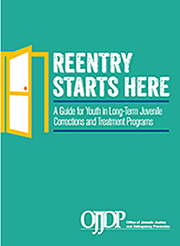 “We started out listing the barriers to reentry and what resources youth need to be successful,” Dr. Dean said. “We often take for granted how difficult it can be to make those transitions, especially in the absence of concrete action steps and a caring adult to help direct the process.”
“We started out listing the barriers to reentry and what resources youth need to be successful,” Dr. Dean said. “We often take for granted how difficult it can be to make those transitions, especially in the absence of concrete action steps and a caring adult to help direct the process.”
Most toolkits are for practitioners, but this guide is geared specifically toward youth. The working group set out to develop a resource that provides useful information and also creates a space for dialogue between youth and individuals guiding the reentry process. One of the guide’s primary goals is to provide action steps a youth can take to be successful once back in his or her community. The guide also creates a base of knowledge that empowers young people, enabling them to advocate for themselves.
“This guide is telling youth, ‘Despite your past mistakes, you can do this. Here is your opportunity to move forward,’” Dr. Dean said. “We are proud to have created something that will hopefully encourage youth to be active participants in shaping their future and reaching their goals.”

By Allison Gilbreath, policy analyst for foster care and juvenile justice at Voices for Virginia’s Children
Growing up in Chesapeake, VA, I first encountered court appointed special advocates (CASAs) for children at the age of 11. My mother suffered from bipolar disorder and was self-medicating. After several suicide attempts, the Department of Social Services was called to the house.
There was no indication that anything was amiss since I was a well-behaved, well-dressed, straight-A student. I stuck to the story that everything was fine but, once my CASA stepped in, she established trust with me over several meetings and I opened up to her. The truth was there was a lot of chaos going on in my house and we really needed help.
I was adamant about not going into foster care. My advocate didn’t make me any promises but she did tell me that she would get help for my mother. That is exactly what happened. My mother was placed in a psychiatric hospital, and I was able to stay with a friend and her family who lived in my neighborhood.
There was something about being able to walk by my house every day that gave me comfort. I remember thinking, “This situation is happening right now, but I’ll be home soon.”
I know that my situation was unique and I don’t take it for granted. I fared better than many children who go into foster care because I was allowed to stay in my neighborhood. This enabled me to stay at my school and continue to participate in school activities. I was able to maintain some normalcy because I was in familiar surroundings.
During this time, so many decisions were made for my life, and I didn’t have a voice, but I felt like I was heard when a CASA became involved. As a result of my experience, I knew I wanted to be a voice for children. I didn’t know exactly how that would manifest in my career but over time I decided on public policy.
Currently, I work on a policy team that focuses on foster care statewide in Virginia. We work with state legislators to advocate for funding and programming to benefit children in foster care. One of my pet projects is a kinship care policy agenda that advocates for capable relatives to take in children before placing them in the foster care system. Family ties and ties to the community are important factors in the success of a child who is removed from the home.
Being a special advocate for children can be a trying job because you can’t follow up on these cases. As a CASA, you step in, handle a crisis, and move on to the next case. On behalf of the kids who don’t get a chance to tell you themselves, I just want to say thank you. You are making a difference.
The National Court Appointed Special Advocate Association (National CASA) supports and promotes court-appointed volunteer advocacy for the more than 600,000 neglected and abused children who find themselves in the child welfare system each year in the United States. National CASA also helps coordinate nationwide campaigns to recruit volunteers and raise awareness about child abuse and neglect.
Since 1985, OJJDP has helped National CASA expand and rigorously train its volunteer corps. In fiscal year 2015, OJJDP awarded National CASA a $5.2 million grant to provide training, technical assistance, and membership accreditation to 949 CASA and/or guardian ad litem (GAL) programs in 49 states and the District of Columbia. Technical assistance now totals more than 22,000 instances per year, in addition to a comprehensive national training program that includes CASA and/or GAL advocate preservice training and issue-focused trainings on ethnic and racial identity, disproportionality, and working with older youth as they transition out of the foster care system to independent living.
__________
Allison Gilbreath is a policy analyst for foster care and juvenile justice at Voices for Virginia’s Children in Richmond, VA. She is dedicated to being an advocate for children and is working to develop policies that improve the lives of children in the foster care system.
Child abuse and maltreatment occur too frequently in our country. In 2016 alone, 7.4 million children were referred to the child welfare system. The associations between maltreatment and potential life outcomes are complicated. However, research shows that children who experience maltreatment or abuse are at greater risk for many potential negative outcomes—including future delinquency.
In 2016, OJJDP funded the nonprofit research organization Child Trends to investigate protective factors in the relationship between maltreatment and delinquency. Protective factors are characteristics of the child, family, or environment that reduce the likelihood of experienced adversities leading to negative outcomes. Using a large, nationally representative sample from the National Longitudinal Study of Adolescent to Adult Health, researchers used self-reported data from youth to examine how certain factors may reduce the potential risk of violent and nonviolent delinquent or criminal behaviors among youth who had experienced maltreatment.
The findings were consistent with earlier studies suggesting that youth who experienced maltreatment in childhood are more likely to engage in both nonviolent and violent delinquent and criminal behaviors. However, they also found certain protective factors could help mitigate this connection.
For nonviolent behaviors, researchers found that a connection to school and a high-quality relationship with a parent or guardian had protective effects that were especially strong for youth who experienced maltreatment.
For violent behaviors, researchers found that a connection to school, a high-quality relationship with a parent or guardian, as well as neighborhood collective efficacy (i.e., the capacity of the community to exert informal social controls) had protective effects for all youth in the sample, and did not vary by maltreatment status. The findings also showed that the effects of the protective factors did not vary by a child’s gender, race and/or ethnicity, or sexual orientation.
These findings are an important reminder to juvenile justice practitioners about the potential benefits of programs that target protective factors. Although a child who has experienced maltreatment may have an increased risk for future offending, efforts to increase access to, and the effectiveness of, programs that promote positive connections to school, strengthen parenting skills and familial relationships, and support resident-driven, public safety initiatives may mitigate or even eliminate this risk.
Resource:
Additional information on OJJDP’s research efforts examining the longitudinal connection between maltreatment and later offending in youth is available online.
The Juvenile Justice and Delinquency Prevention Act that established OJJDP authorizes the Administrator to conduct research and evaluations and undertake statistical analyses on issues related to juvenile offending and victimization. Because OJJDP is the only Office of Justice Programs agency with dual mandates for research and programs, we are uniquely positioned to integrate research in our programmatic functions, and we are committed to translating research into practice.
Look to this recurring column authored by members of OJJDP’s Research Unit to distill topically relevant and timely OJJDP-supported research.
Child Homicide Investigations: August 27–28, 2018
 The OJJDP-sponsored National Criminal Justice Training Center will conduct this training in Irving, TX. Presenters will help participants understand relationship building with forensic pathologists, homicide investigators, and prosecutors to successfully investigate and prosecute child homicide cases. Topics include learning autopsy and forensic protocols, determining cause and manner of death, understanding interviewing and interrogation, developing a suspect pool, and understanding the importance of the prosecutor in gaining appropriate convictions. Registration information is available online.
The OJJDP-sponsored National Criminal Justice Training Center will conduct this training in Irving, TX. Presenters will help participants understand relationship building with forensic pathologists, homicide investigators, and prosecutors to successfully investigate and prosecute child homicide cases. Topics include learning autopsy and forensic protocols, determining cause and manner of death, understanding interviewing and interrogation, developing a suspect pool, and understanding the importance of the prosecutor in gaining appropriate convictions. Registration information is available online.
The training will also be held on October 15–16, in Richfield, OH.
Leveraging Program Evaluation and Data To Improve Your Services—Part One: September 13, 2018
This two-part webinar hosted by the Midwest Regional Children's Advocacy Center and sponsored by OJJDP will provide an overview of program evaluation, discuss the various types of evaluation, and cover how to select the best type of evaluation based on specific organizational needs. Registration information is available online.
Part two of the training will be held on September 27, 2018.
Advanced Leadership—Developing an Outward Mindset: September 13–14, 2018

The OJJDP-sponsored Southern Regional Children’s Advocacy Center will host this training in Huntsville, AL. Presenters will explore how to shift to an inward mindset (focusing on oneself and one’s objectives) and the implications that has on one’s own work and that of others, as well as how to leverage a framework that will guide work in an outward mindset (focused on helping others). For additional information on the training, call 256–327–3808 or email Meredith Wilkes at [email protected].
Conducting Unexplained Child Death Investigations: September 17–20, 2018
The National Criminal Justice Training Center will host this training in San Diego, CA. Attendees will learn about the defining causes of and multidisciplinary responses to child death, investigative protocols involving pediatric medical emergencies and child deaths, standard interview and interrogation procedures, and wellness resources available for assistance in dealing with vicarious trauma and compassion fatigue. Registration information is available online.
The Trauma Informed Judicial System—Creating Safe Spaces for Tribal Youth: September 19, 2018
This webinar, sponsored by OJJDP’s Tribal Youth Training and Technical Assistance Center, is designed for tribal juvenile justice system providers working in court-based settings. Presenters will discuss how to create safe spaces for tribal youth within the trauma-informed judicial system. The webinar will provide a brief overview of the impact of trauma in tribal communities, and discuss the principles of trauma-informed care. The webinar will also present practical strategies and public health responses that tribal community court services may provide to support a trauma-informed environment for tribal youth who are justice involved. Registration information is available online.
Multidisciplinary Team Responses to Child Sex Trafficking: September 24–27, 2018
The National Criminal Justice Training Center will conduct this team-based training in Harrisburg, PA. Presenters will guide existing multidisciplinary teams to improve their response to child sex trafficking and assist those seeking to establish a formal multidisciplinary team in their communities to effectively respond to trafficking cases. Topics include understanding child sex trafficking, the use of technology in trafficking cases, the role of children's advocacy centers in trafficking responses, and effectively implementing action plans. Registration information is available online.
National Symposium on Juvenile Services: October 22–25, 2018
The OJJDP-supported National Partnership for Juvenile Services is hosting this symposium in Greensboro, NC. This event will bring together juvenile and human services leadership and professionals for training and the opportunity to share program approaches being implemented within the juvenile justice system nationwide. OJJDP staff and grantees will present workshops on promising practices and critical juvenile justice issues, such as sexting and cyberbullying. Registration information is available online.
OJJDP Staff Presents at American Probation and Parole Association Institute
Administrator Harp attended the American Probation and Parole Association's (APPA's) 43rd Annual Training Institute held July 29–August 1, 2018, in Philadelphia, PA. The institute—with the support of OJJDP's Juvenile Community Supervision Improvement program, the Council of State Governments Justice Center, and the Robert F. Kennedy National Resource Center on Juvenile Justice—featured a symposium on July 30 regarding the future of juvenile community supervision.
On July 31, OJJDP Research Coordinator Jennifer Tyson presented in the session, "Bridging Research and Practice in Juvenile Justice: A Research-Informed Approach to Youth Probation." She noted that the goals of OJJDP’s Bridge Project were to:
- Identify areas where research has not been integrated into policy and practice.
- Translate juvenile justice research into innovative products and dissemination strategies.
- Drive changes in policy and practice.
Dr. TeNeane Bradford, OJJDP’s Associate Administrator of the Core Protections division, met with APPA’s Juvenile Justice Committee to discuss the Office’s work on state compliance with the core requirements of the Juvenile Justice and Delinquency Prevention Act and consolidation of the Office’s Title II Formula Grants program work into the State Relations and Assistance division.
Operation Broken Heart Results in the Arrest of More Than 2,300 Suspected Child Sexual Predators

OJJDP’s Internet Crimes Against Children (ICAC) Task Force leads the annual national Operation Broken Heart effort. The operation coordinates multiple proactive operations by the 61 ICAC task forces, more than 4,500 affiliate agencies, and federal partners. The most recent operation took place March 1 to May 31, 2018. Operation Broken Heart targets individuals who—
- Produce, distribute, receive, and possess child pornography.
- Entice children online for sexual purposes.
- Engage in sex trafficking of children.
- Travel internationally or cross state lines to sexually abuse children.
This year’s effort, Operation Broken Heart V, resulted in the arrest of more than 2,300 suspected online child sex offenders. The task forces identified 195 suspects who produced child pornography or committed child sexual abuse, and 383 children who suffered recent, ongoing, or historical sexual abuse or production of child pornography. The task forces also delivered more than 3,700 presentations on Internet safety to more than 390,000 youth and adults during those 3 months.
OJJDP launched the ICAC Task Force program in 1998 to help federal, state, and local law enforcement agencies enhance their investigative responses to offenders who use the Internet, online communication systems, or computer technology to exploit children. To date, ICAC task forces have reviewed more than 775,000 complaints of child exploitation, which resulted in the arrest of more than 83,000 individuals. In addition, since the program’s inception, more than 629,400 law enforcement officers, prosecutors, and other professionals have been trained on techniques to investigate and prosecute ICAC-related cases.
Read a press release about Operation Broken Heart V.
OJJDP Adds Juvenile Residential Facility Data to Statistical Briefing Book
 OJJDP has updated its Statistical Briefing Book with national and state data from the 2016 Juvenile Residential Facility Census. Developed for OJJDP by the National Center for Juvenile Justice, the research division of the National Council of Juvenile and Family Court Judges, the Statistical Briefing Book provides easy online access to statistics on a variety of juvenile justice topics.
OJJDP has updated its Statistical Briefing Book with national and state data from the 2016 Juvenile Residential Facility Census. Developed for OJJDP by the National Center for Juvenile Justice, the research division of the National Council of Juvenile and Family Court Judges, the Statistical Briefing Book provides easy online access to statistics on a variety of juvenile justice topics.
Updated offerings in the Statistical Briefing Book include:
- A data snapshot describing facility screening practices and service availability.
- Answers to frequently asked questions about facility characteristics, practices, and services.
- The Juvenile Residential Facility Census Databook, which facilitates independent analysis of data on the characteristics of youth residential placement facilities from 2000 to 2016, including:
- U.S. and state profiles providing national and state-level tables describing detailed information about facility operation, classification, size, and capacity.
- State comparisons of residential placement facility characteristics by operation, classification, size, and capacity.
- Methods information on the Juvenile Residential Facility Census data collection.
- A glossary that defines key terms used.
National Juvenile Court Data Archive Workshop Focuses on Using Data To Improve Youth Outcomes
 The 2018 Workshop for Contributors to the National Juvenile Court Data Archive, held May 31–June 1, 2018, in Greenville, SC, offered presentations on juvenile justice system modernization efforts, raising the age of juvenile court jurisdiction, and racial and ethnic disparity analysis for youth in custody. Other presentations highlighted differences across states in using probation risk and needs assessment tools, and using electronic fingerprints to build risk assessments.
The 2018 Workshop for Contributors to the National Juvenile Court Data Archive, held May 31–June 1, 2018, in Greenville, SC, offered presentations on juvenile justice system modernization efforts, raising the age of juvenile court jurisdiction, and racial and ethnic disparity analysis for youth in custody. Other presentations highlighted differences across states in using probation risk and needs assessment tools, and using electronic fingerprints to build risk assessments.
The National Center for Juvenile Justice (NCJJ) hosted the OJJDP-funded workshop, which was attended by 39 representatives from juvenile courts or other juvenile justice agencies in 29 states that contribute case-level data to the OJJDP-funded National Juvenile Court Data Archive. OJJDP Social Science Analyst Barbara Tatem Kelley welcomed participants and updated them on OJJDP's fiscal year 2017 research awards and planned research initiatives for fiscal year 2018.
Guest speaker Monty Prow, quality improvement services director for the Idaho Department of Juvenile Corrections, discussed using continuous quality improvement to achieve long-term outcomes for youth released from state custody. David Barrett, associate dean of academic affairs and research at Clemson University’s College of Education, presented on a multiagency cohort study on juvenile delinquency and recidivism. During the 2-day workshop, NCJJ staff also reviewed the OJJDP-funded National Juvenile Justice Data Analysis Program, highlighted content updates to OJJDP’s Statistical Briefing Book, and presented current analyses from both the Data Analysis and Data Archive projects.
OJJDP Recognized for Excellence in Communications
OJJDP’s Communications Unit has received five communications awards for its Fiscal Year 2016 Awards infographic and the May/June 2017 OJJDP News @ a Glance article, "Justice Department Observes National Missing Children’s Day."
The infographic received a Grand Award for Design & Illustration from the 2018 APEX Awards for Publication Excellence, a second place 2018 Blue Pencil & Gold Screen Award in the Infographic (External) category from the National Association of Government Communicators (NAGC), and an Award of Distinction from The Communicator Awards in its Online Advertising & Marketing/Image and Infographic category.
The article, "Justice Department Observes National Missing Children’s Day," won a 2018 Blue Pencil & Gold Screen Award of Excellence in the Mobile Web Article category, as well as an Award of Distinction in the Communicator Awards’ Writing/Feature Article category.
APEX Awards acknowledge outstanding graphic design, editorial content, and communications effectiveness. NAGC advocates for, promotes, and recognizes excellence in government communication. The Academy of Interactive & Visual Arts presents the Communicator Awards to projects that exceed industry standards in quality and achievement.
All OJJDP publications may be viewed and downloaded on the publications section of the OJJDP website. Print publications may be ordered online at the National Criminal Justice Reference Service website.
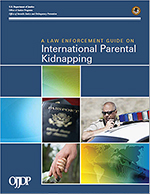
A Law Enforcement Guide on International Parental Kidnapping
NCJ 250606
OJJDP developed this guide to help federal, state, and local law enforcement authorities successfully investigate international parental kidnapping cases. It addresses how to prevent international child kidnappings by family members; describes the role of law enforcement as the initial responder and investigator; discusses applicable laws, treaties, and legal remedies for child recovery and reunification; and outlines considerations for criminal prosecution and extradition of offenders.
Read and download A Law Enforcement Guide on International Parental Kidnapping.
Reentry Starts Here: A Guide for Youth in Long-Term Juvenile Corrections and Treatment Programs
NCJ 251193
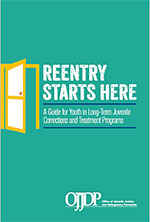
Each year thousands of youth transition from confinement back to their communities. OJJDP produced this guide to help youth and their families plan and prepare for reentry so the youth go on to live productive and crime-free lives.
The guide is divided into two sections. Part one outlines steps youth can take to plan for reentry while they are in placement (e.g., build a reentry team, develop a plan with the team, get help from lawyers and mentors, connect with support services, and plan ahead for school and work). Part two outlines steps youth can take to be successful upon return to their communities (e.g., use all available social and medical services, follow all probation order/parole agreement requirements and conditions, complete school, obtain employment, and manage money).
Read and download Reentry Starts Here: A Guide for Youth in Long-Term Juvenile Corrections and Treatment Programs.